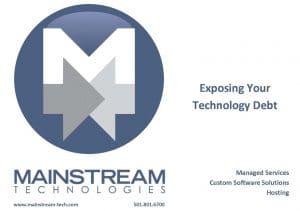 Do you know the size of your technology debt and how it’s affecting your organization?
Do you know the size of your technology debt and how it’s affecting your organization?
Technology Debt is the total cost to your organization for using outdated, unsupported, or poorly architected technologies. Technology Debt (TD) is always with us in some form or fashion since once a product is installed it begins to age and eventually ends up becoming outdated. It’s not necessarily bad but it must be managed to keep it under control. Neglected or unmanaged Technology Debt is dangerous and can lead to unplanned costs (both hard and soft).
The cost factors of TD may include (but are not limited to):
- Reduced employee productivity,
- Inefficient business processes,
- Unexpected or unwarranted downtime,
- Service restoration (both time and money)
- Unnecessary risk to the business due to inadequate DR or Business Continuity planning, and
- The eventual replacement costs for a technology refresh.
Does your workplace exhibit any of the common symptoms of neglected Technology Debt?
- Misalignment of processes and technology
- Employees have workarounds to get the job done in spite of their technology
- Stress in business processes generally results in productivity delays or employee workarounds
- Undue complexity in a process that is required to complete a given task
- System insecurity that exposes your information to unnecessary risks
- Unstable or lethargic system performance
- Unplanned downtime that results in lost productivity and added costs to restore services
- Insufficient business continuity or disaster recovery planning
- Inadequate 3- 5-year technology planning which results in firefighting or ‘reactive’ management
Most IT professionals know and appreciate the challenges of Technology Debt. However, their non-IT peers rarely are aware of or appreciate the size, complexity, and risks that this debt poses. IT professionals have the challenge of both managing their technology and advocating to their peers for best practices so their debt doesn’t get out of control.
IT All-stars will take the initiative to measure their debt so that when the time comes to defend why the company should invest in fixing or replacing a system that nobody wants to pay for, they have the justification at their fingertips.
While no one can avoid technology debt, it’s time to wrap your arms around it. It’s never too late to do the right thing.
Here are six things you can do to get a better handle on your debt:
Where are we?
- Identify all of your technology assets.
-
- Which ones are out of date (warranty)?
- How long have they been out of date (warranty)?
- If under warranty, how much time is left on the warranty?
- Create a 3 – 5-year plan to update these assets starting with the most susceptible to failure or the greatest impediment to productivity first.
- Track all operating costs with respect to the products and processes they support.
-
- Can these assets and their operating costs be justified based on the benefits they provide to the business?
Where are we going?
- Create a budget for technology renewal to underwrite ongoing refresh efforts throughout the enterprise. Remember, Technology Debt can’t be eliminated.
- Create a list of features that the company wants. This will help identify appropriate technologies to replace the legacy systems scheduled for replacement.
- Consider leveraging cloud technologies or software as a service solutions which can reduce your capital outlay while possibly bringing new features to your staff. Either of these technologies may include regularly scheduled maintenance and updates that you were providing for the legacy systems.
ABOUT MAINSTREAM TECHNOLOGIES
Mainstream Technologies is a Little Rock, AR IT service company. We offer managed technology services, data center services, custom software development, and cybersecurity services. If you would like help analyzing the ROI of proactive IT management, call us @ 800.550.2052 or click here to send us an email.
##





